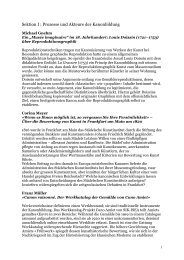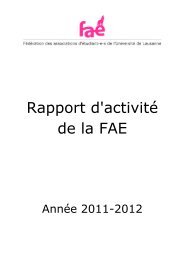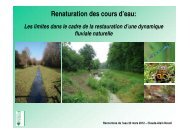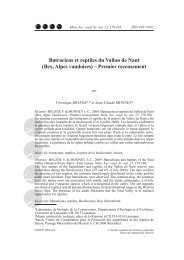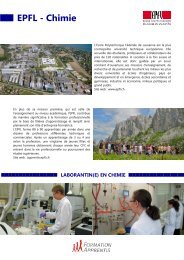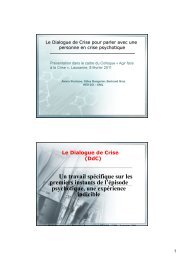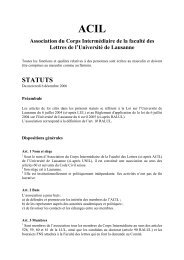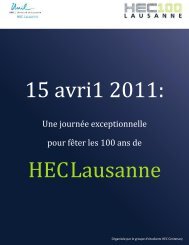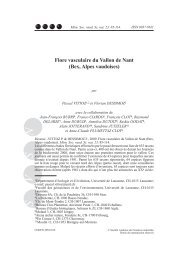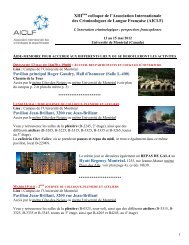Suivi piscicole du Brassu et du Nant de Pry, deux affluents du ...
Suivi piscicole du Brassu et du Nant de Pry, deux affluents du ...
Suivi piscicole du Brassu et du Nant de Pry, deux affluents du ...
You also want an ePaper? Increase the reach of your titles
YUMPU automatically turns print PDFs into web optimized ePapers that Google loves.
122<br />
A. Richard <strong>et</strong> J-F. Rubin<br />
néanmoins à relativiser, car les écarts-types restent forts. Concernant les<br />
tailles rétrocalculées à 2 <strong>et</strong> 3 ans, aucun écart entre les <strong>de</strong>ux cours d’eau n’est<br />
significatif (respectivement p = 0.776 <strong>et</strong> p = 0.753). Sur le Boiron <strong>de</strong> Morges,<br />
la courbe <strong>de</strong> croissance <strong>de</strong>s truites diffère <strong>de</strong> celle obtenue sur le <strong>Brassu</strong> <strong>et</strong><br />
le <strong>Nant</strong> <strong>de</strong> <strong>Pry</strong>. La croissance lors <strong>de</strong> la première année est plus forte sur le<br />
Boiron que sur le <strong>Brassu</strong> (t-test, p < 0.001) <strong>et</strong> le <strong>Nant</strong> <strong>de</strong> <strong>Pry</strong> (t-test, p < 0.001) ;<br />
cependant, c<strong>et</strong>te tendance s’estompe avec l’âge. A <strong>de</strong>ux ans, aucune différence<br />
<strong>de</strong> taille significative n’est visible entre les truites <strong>de</strong>s trois cours d’eau<br />
(ANOVA à un facteur contrôlé, p = 0.888), ni à trois ans (ANOVA à un facteur<br />
contrôlé, p = 0.196). Pour les indivi<strong>du</strong>s plus âgés, le faible nombre <strong>de</strong> captures<br />
ne perm<strong>et</strong> pas d’analyses statistiques satisfaisantes. Les effectifs <strong>de</strong> géniteurs<br />
âgés <strong>de</strong> 4 ans <strong>et</strong> plus restent en eff<strong>et</strong> très faibles sur le <strong>Brassu</strong> (n = 4) <strong>et</strong> le <strong>Nant</strong><br />
<strong>de</strong> <strong>Pry</strong> (n = 7).<br />
Tableau 8.–Taux <strong>de</strong> recapture <strong>de</strong>s truites sur trois stations <strong>du</strong> <strong>Brassu</strong>, en 2006.<br />
Cohorte<br />
Age<br />
en<br />
2006<br />
Effectif<br />
total<br />
BR2 BR3 BR4<br />
taux<br />
recapture<br />
(%)<br />
Effectif<br />
total<br />
taux<br />
recapture<br />
(%)<br />
Effectif<br />
total<br />
taux<br />
recapture<br />
(%)<br />
2005 1+ 32 22 31 10 14 7<br />
2004 2+ 4 100 6 83 1 0<br />
2003 3+ 4 75 12 58 - -<br />
2002 4+ 1 100 1 100 1 100<br />
2001 5+ - - 1 100 - -<br />
Tableau 9.–Taux <strong>de</strong> recapture <strong>de</strong>s truites sur <strong>de</strong>ux stations <strong>du</strong> <strong>Nant</strong> <strong>de</strong> <strong>Pry</strong>, en 2006.<br />
Cohorte<br />
Age<br />
en<br />
2006<br />
Effectif<br />
total<br />
NP3<br />
taux<br />
recapture<br />
(%)<br />
Effectif<br />
total<br />
NP4<br />
taux<br />
recapture<br />
(%)<br />
2005 1+ 38 26 21 10<br />
2004 2+ 3 33 8 50<br />
2003 3+ 1 100 2 100<br />
2002 4+ 2 100 2 50<br />
2001 5+ 2 50 1 100



